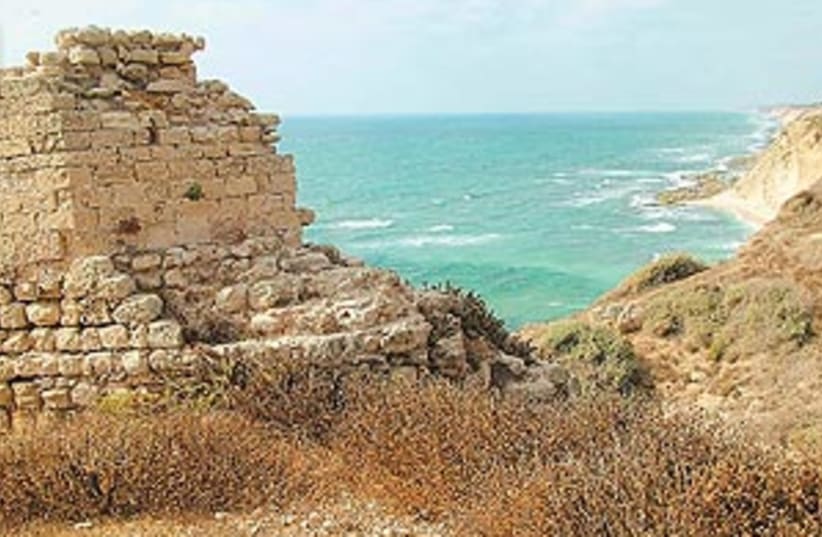Split neatly into two equal halves by the ancient and medieval ruins of Apollonia, this section of the Israel Trail follows the Mediterranean coast. It affords the company of fast walkers and joggers, and you will never be more than an hour away from liquid refreshment. Bring your own, as a Coca-Cola costs NIS 8 and a passionfruit cocktail tops out at a staggering NIS 30.

Begin at Herzl Beach at the center of Netanya, with the official southbound trail over the tops of the cliffs, before descending near Argaman Beach.
Most of the coast is unguarded, so keep out of the water unless it is a supervised swimming zone. The beaches appear sandy, but if you step inside the surf you will be on a rocky shelf — the base of cliffs cut by constant wave action, and in July, home to platoons of jellyfish. The lethal rip-currents, whirlpools and undertows claim many victims each year.
Pollution is also a serious problem: Israel’s beaches are cleaner than most Mediterranean countries, but several rivers, for example the Poleg, have no sewage treatment works.
Watch out for three hazards.
* The cliffs: severe erosion from storm waves has made some of them unstable.
* Paddle-ball games: The rubber projectile delivers a potent whack.
* Beached jellyfish: I nearly picked one up. It was so perfectly formed that I thought it was the salt-encrusted hat of a Hassid.

An hour and a half’s walk from Netanya brings you to the mouth of the Poleg River, with the Wingate Institute perched high above. Stop in this area for some rest and refreshments. The next couple of hours to Apollonia are quite demanding, as the trail makes it way along the sometimes sandy and sometimes rocky sea shore. It ascends more than half an hour later through gullies up to the cliffs (where the path keeps far from the edges), and past the hot springs of Ga’ash and Shefayim.
The trail eventually goes inland, carrying you a short distance along the southbound carriageway of the busy Route No. 2 before making a sharp right back into the plush, tree-lined, villa-civilization of Herzliya Pituah. Its inhabitants appear to buy in bulk: the local supermarket would only agree to sell a single bottle of mineral water after considerable negotiation. As you get back to the coast, a brown sign beckons you to inspect the excavations of Apollonia (closing time 5 p.m.), which you may do for NIS 16.
ARCHEOLOGICAL EVIDENCE below the Crusader town wall shows that the settlement was founded by the Phoenicians at the end of the sixth century BCE — under the ancient Persian Empire. A seafaring people, they used the small natural cover as an anchorage for the ships that linked them geographically to the already flourishing Greeks, who were to displace the Persians and establish a far more formidable presence in the region. In fact the port picked up its present name Apollonia under the Greeks, in honor of Apollo, their god of war and storms.
Continuing to expand under the Romans (with its villa remains viewable near the parking lot), it reached its zenith under the fifth-sixth century CE Byzantines. By that time it was a city, with its people employed in glass- making, wine-making and oil-pressing. The plastered water reservoirs and cisterns on the way to the Crusader Fortress date from this period. Indeed, the city’s water supply depended on the collection of rainwater in those structures.
Walled during the early Muslim period, the city fell in 1101 to Crusader King Baldwin I and his Genoan fleet. Renaming it Arsour, the Crusaders reinforced the walls with their characteristic moat and glacis structure of the same stamp as in Ashkelon, Caesarea and Acre. By 1241 they were facing an overpowering threat from Mameluke Muslims. As a last resort, the Crusaders put up the fortress in the northern part of the town, whose remains are the best- preserved part of the site. It lasted 24 years and finally surrendered to the army headed by Mameluke Sultan Beybars. Its ruins are not due to mere neglect, but to Beybars, who forced its defenders to destroy the fortress before taking them prisoner.
The trail descends past the picturesque Arsuf Mosque to the seashore, with a stark change of character as it rounds the final cliff and jettisons you out of antiquity and coastal landforms into the 21st-century chi-chi Sharon seaside resort. The next hour presents sandy beaches and the up-market costa concrete of hotels along the Herzliya Marina to the Dan Arcadia. Many, if not most, of the people on the beach are children, in contrast with less than 10 percent on a recent trip to the coastal resort of Schveningen, Netherlands.
The roadwork gives way to a very pleasant stretch of kurkar (deep reddish calcareous sandstone) backed cliffs, a pleasing change from the gray-white limestone backing previous sections of the trail. The plants growing on the ridge, which are very resistant to salt spray and the sandy cover, include lavender and yellow evening primrose.

Do not turn right at the Tel Baruch Beach junction, as the way along the coast by Sde Dov Airport to Tel Aviv is blocked by Reading Power Station. Instead, the trail bears 3 km. of roadworks until the end of this section. It follows Rehov Zvi Propos, avoiding Tel Aviv University by turning right southwards along the long ruler-straight Levi Eshkol thoroughfare, with the Ramat Aviv high-rises. Though it was late, I was overtaken by armies of joggers and cyclists on the newly built cycle tracks, which eventually make a sharp right into Rehov Shai Agnon, and a final 90- degree left turn to the terminus of this section over the Bar-Yehuda Bridge on the Yarkon River.
| More about: | Levi Eshkol, Shmuel Yosef Agnon, Tel Aviv University, Sde Dov Airport |
